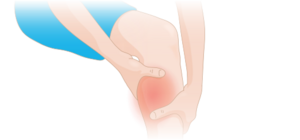Muscle Cramps
Original Editors - Habibu Salisu Badamasi
Top Contributors - Habibu Salisu Badamasi and Matt Huey
Introduction[edit | edit source]
Muscle cramps are mostly idiopathic, commonly affecting the calf muscles and/or foot. Muscle cramps are usually short-lived and self-limited, but may be results from varieties of serious systematic disorders. [1] Physical examination and review of medical history can rather quickly and simply rule out cramps caused by pathologies. Passive and/or active stretching of the affected muscle(s) is by far the most effective and safest non-pharmacology management for most acute idiopathic muscle cramps.[1]
Definition[edit | edit source]
A muscle cramp is a sudden, involuntary, painful muscle contraction or spasm, associated with an increase in frequency of motor action potentials and can have persistent muscle soreness and swelling with a variable rate of improvement, often terminated by stretching.[1] [2]
Mechanism[edit | edit source]
The precise pathophysiology remains unknown. However, muscle cramps are due to reactivation of the nervous system. The part of the nervous system activated are motor neurons or the terminal branches of motor axons and sensory neurons and this aspect distinguishes it from contracture which , however is electrical silent.[3]
Epidemiology[edit | edit source]
Epidemiological survey, shows that approximately 37% of the healthy population per year are affected by muscle cramps, forming the frequently reported complain to general practitioners and neurologists.[3]
Risk Factors[edit | edit source]
Etiology[edit | edit source]
- Primary cramps:(Idiopathic) They are cramps that occur without any apparent cause, often nocturnal. Common in particular circumstances, at night or during pregnancy.
- Exercise-induced:( physiological) for example during or after Strenuous exercise
- Secondary cramps: They occurs as a consequences of particular neurological or metabolic disorders.
- Multiple sclerosis
- Haemodialysis
- Cirrhosis
- Metabolic or electrolyte disturbances
- Other chronic diseases
Assessment[edit | edit source]
Most people presenting with cramps have idiopathic cramps, which are usually diagnosed following clinical exam. Further investigations are only required if the cramp has atypical features or other associated conditions are suspected.[1]
- Past medical history- Consider patient past medical that may increase suspicion of an organic cause.
- Blood test- serum or urine hCG, fasting serum metabolic panel, thyroid-stimulating hormone (TSH), HbA1c, serum liver function tests, prothrombin time (PT) and INR, serum myoglobin and urinalysis.
- Neurological examinations: may indicate nerve involvement with muscle wasting, weakness, fasciculations etc.
- other investigations: electromyogram, nerve conduction test, muscle biopsy, genetic studies etc.
Management[edit | edit source]
Conservatives management: performing stretching to the affected part is the most effective and quickest management to counteract the involuntary contractions.
Pharmacological management: Medication can be consider, which are active on the nervous systems. They act by counteract reactivation of motor neurons
Prevention[edit | edit source]
Prevention in healthy subjects could involve adequate hydration, correct heating before physical activity and advise performing stretching exercises of the muscles involved both during and after the physical activity. For the different pathologies also characterized by the appearance of cramps, there are no accepted guidelines as valid on the pharmacological approach in any pathological state.[4]
Resources[edit | edit source]
References[edit | edit source]
- ↑ 1.0 1.1 1.2 1.3 BMJ best practice.Muscle Cramps. Available from: https://bestpractice.bmj.com/topics/en-gb/569 (accessed on 30July 2023).
- ↑ Katzberg HD. Case studies in management of muscle cramps. Neurologic clinics. 2020 Aug 1;38(3):679-96.
- ↑ 3.0 3.1 Dijkstra JN, Boon E, Kruijt N, Brusse E, Ramdas S, Jungbluth H, van Engelen BG, Walters J, Voermans NC. Muscle cramps and contractures: causes and treatment. Practical Neurology. 2023 Feb 1;23(1):23-34.
- ↑ Bordoni B, Sugumar K, Varacallo M. Muscle Cramps. [Updated 2023 Aug 4]. In: StatPearls [Internet]. Treasure Island (FL): StatPearls Publishing; 2023 Jan-. Available from: https://www.ncbi.nlm.nih.gov/books/NBK499895/







